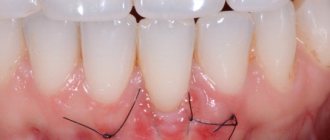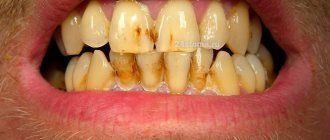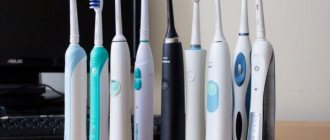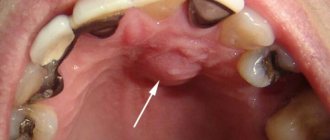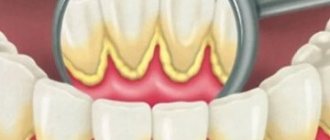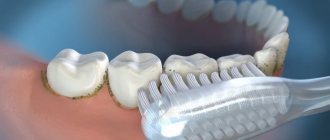According to scientists, tooth enamel is the hardest and most durable tissue in our body. And this is not surprising, because it is the enamel that withstands serious onslaught from the outside every day: mechanical friction when chewing food, chemical effects of substances contained in food and drinks, etc.
As long as the enamel is intact, the teeth remain healthy and strong. But as soon as it begins to thin out, the first signs of caries appear on the teeth - visible destruction, which can lead to complete loss of the tooth. Time-tested and latest recovery technologies help prevent negative processes.
Causes of destruction of the enamel layer of teeth
Enamel is a mineral layer about 2 mm thick that covers the crown of the teeth.
97% consists of a crystalline substance of hydroxyapatite with small inclusions of calcium, fluorine, magnesium, and carbon. Performs a protective function, protects dentin and pulp from external influences. This is the hardest tissue in the human body; 1 square millimeter of its area can support 397.6 kg. But, nevertheless, even such a durable material can begin to deteriorate due to exposure to physical or chemical factors. The most common causes of enamel destruction:
- accumulation of plaque due to poor hygiene;
- exposure to concentrated acids contained in natural juices and carbonated drinks;
- unbalanced diet, large amounts of carbohydrates in the daily diet;
- mechanical injuries to the tooth crown with the formation of cracks and chips;
- bad habits of chewing pens and pencils;
- bite defects;
- wearing braces;
- abnormal abrasion of the enamel layer;
- bruxism (uncontrolled teeth grinding);
- sudden changes in temperature (for example, hot coffee after ice cream);
- diseases accompanied by leaching of calcium from the body (diabetes mellitus and other pathologies of the endocrine system);
- hereditary factor;
- stomach diseases in which the absorption of calcium and phosphorus is impaired;
- metabolic destabilization;
- caries;
- periodontal diseases;
- age-related tissue nutritional disorders.
Causes of the disease
The exact causes of tooth enamel erosion have not been determined. Dentists do not exclude the possibility of developing the disease in every person, even with constant monitoring of oral health.
But there are a number of possible provoking factors.
- Mechanical. The enamel can be damaged by mechanical stress due to excessive pressure on the teeth with a brush with hard bristles, or the use of a whitening paste with large abrasive particles. The surface of the tooth is also often damaged in people who have the habit of gnawing something or opening jars with their teeth, etc.
- Chemical. The highest risk is the chemical factor, which involves excessively frequent consumption of drinks or foods with high acidity.
- Endocrine. The connection between the functioning of the thyroid gland and the condition of tooth enamel has not been determined, but according to research, in patients with hyperthyroidism, tooth erosion occurs much more often.
- Anatomical. In case of malocclusion or the absence of chewing teeth, the distribution of the load on the dentition occurs unevenly, which leads to the abrasion of the enamel on the teeth, onto which all the pressure is redistributed.
- Medication. Some medications also have an impact on the condition of teeth as a side effect.
- Hereditary. Problems with tooth enamel can be genetic and are often inherited.
According to statistics, erosion of tooth enamel is detected mainly in women over the age of 35 years. But pathology is increasingly being diagnosed in children with baby teeth.
How to determine when it’s time to restore enamel
In order to preserve the integrity of the enamel layer as much as possible (or at least stop its destruction), it is very important not to miss the first signs of the pathological process. Its initial stages are characterized by demineralization of a local area of the tooth surface. It looks like a white, non-glossy spot. This clinical picture is called caries in the white spot stage. Another sign is the appearance of tooth sensitivity. Normally, a person does not feel the touch of the tongue on the teeth, there are no unpleasant sensations when chewing food. There is also no reaction when the teeth come into contact with cold, hot, sweet or sour foods. If any of the listed signs appear in the patient, this means that the enamel layer of his teeth has begun to gradually deteriorate. The following stages of enamel corrosion are visible to the naked eye. A local dark area forms on the surface of the tooth, then it begins to expand in area and go deeper into the dentin. These are signs of a serious defect. Correcting it will require more complex measures than when the first symptoms appear.
Important: a person cannot always independently see the stage of a white spot or a small black spot. Therefore, it is extremely important to visit your dentist for a checkup twice a year. Specialists from our network of clinics will be able to promptly detect an emerging defect and eliminate the damage with minimal intervention in the tooth structure (or without it at all). Our branches are equipped with modern equipment and instruments, including dental microscopes for diagnosis and treatment.
Ways to prevent tooth enamel destruction
Don't want the enamel on your teeth to be destroyed? Then you should follow certain rules:
- visit the dentist regularly. As soon as you notice any sign of enamel destruction, immediately go to a specialist. You shouldn’t wait for a scheduled appointment; it’s better to treat your teeth right away to avoid any complications;
- take good care of your teeth. When brushing your teeth, do not press too hard on the brush, because this damages the enamel. It can also be damaged due to sudden movements and hard bristles. It is worth using soft bristles, brushing your teeth with smooth movements and cleaning hard-to-reach places;
- get rid of tooth friction. Do you find yourself clenching your jaw? It is worth eliminating this habit, as it contributes to rapid abrasion and wear of the enamel. Dentists can tell you how to stop grinding your teeth;
- get rid of bad habits. Avoid biting your nails, chewing plastic lids, pens, ice or tobacco. You should also stop drinking alcohol. After all, such drinks soften the enamel, and it begins to collapse. It is better not to drink carbonated drinks and juices, because they contain a lot of sugar;
- medicines. There are medications that destroy enamel. This. For example, vitamin C, aspirin, antihistamines. They contain a lot of acid, so it negatively affects the teeth.
Restoration methods for the initial stage of destruction
Restoration of tooth enamel is the implementation of measures aimed at reconstructing the appearance of the enamel layer and restoring the protective functions it performs.
It is performed using various methods depending on the condition of the enamel. The earlier measures are taken, the better the effect. When initial symptoms appear, the following measures are effective:
- professional hardware teeth cleaning;
- remineralization – saturation of enamel with essential minerals, including fluoridation (coating teeth with a special varnish).
Note: it is impossible to restore enamel at home. The patient can only help the doctor. To do this, he must review his diet, carefully carry out hygienic dental care, eradicate bad habits, and begin treating systemic diseases (if any).
Consequences of abrasion of the outer shell
Thinning of tooth enamel is a rather alarming situation; it threatens the integrity of all elements of the series. When the upper protective layer is damaged under the influence of certain factors, the inner part, the dentin, is exposed. And since this tissue is somewhat softer and more permeable than the hard shell, its destruction will be quite rapid. When the dentin boundaries are open, nothing prevents microbes from quickly penetrating into the pulp and starting the inflammatory process.
The consequence of this is the rapid destruction of bone tissue due to the development of caries, pulpitis or periodontitis. It happens that the ligaments that hold the teeth in the sockets are involved in the inflammatory process. In this case, they will inevitably be lost over time. That's why it's important not to hesitate to see a doctor at the first sign of increased tooth sensitivity, loss of shine, or staining.
Restoration methods for serious enamel defects
In cases where the enamel layer has undergone significant destruction, a set of measures consisting of two stages is indicated, the first of which is dental treatment of the damaged tooth. Only then will the dentist begin the actual restoration. This could be the application of artificial enamel, composite restoration or dentures. The methods listed above help stop decay, restore the appearance, and protect the inner layers of the tooth.
Relatively small defects can be eliminated by applying artificial enamel or composite reconstruction (the doctor uses special materials to recreate the shape of the tooth). More serious problems of the enamel layer are solved by installing microprostheses (veneers or lumineers). These are the thinnest pads that the orthopedist fixes to the vestibular surface. If the dental element is destroyed to a significant extent, then the doctor forms a stump and installs a crown on it.
Note: the choice of restoration option for the enamel layer is made by the dentist after diagnostics and identification of the extent of the damage.
Strengthening tooth enamel at home
It is possible to strengthen the enamel through the process of remineralization. Currently, there are many products on the market that are popularly called liquid enamel or artificial enamel. Thanks to them, a strengthening procedure is possible. Treatment should be performed before irreversible tissue loss occurs in the tooth.
The most popular pastes for strengthening enamel are fluoride-based preparations. Fluoride ions replace dissolved hydroxide ions in the enamel and form fluorapatite, which is more resistant to caries. In addition, fluoride inhibits bacterial activity. Strengthening of enamel also occurs as a result of the use of drugs with a complex of casein phosphopeptide and amorphous calcium phosphate.
Enamel remineralizing toothpaste is an ideal complement to standard fluoride toothpaste. As preparations that restore mineral balance in the oral cavity, they are well suited for people with caries problems and are recommended after professional teeth cleaning and tartar removal. Thanks to their pleasant scents, they are easy to use even for children. Once again, it is worth saying that there is no toothpaste that restores enamel defects.
Regular preventative visits with professional remineralization are the best way to strengthen tooth enamel.
Prevention measures
- Careful hygiene at home - at least twice a day, every day
- Clinic visits for professional cleaning – once or twice a year
- Eating foods high in vitamins and minerals
- Reducing intake of high carbohydrate foods
- Avoiding carbonated sugary drinks
- Timely treatment of dental and periodontal diseases
The network of dental clinics “Smile” offers services for restoring tooth enamel. Contacting our specialists has a number of undeniable advantages:
- treatment by highly qualified doctors;
- compliance with treatment protocols that meet international standards;
- family and savings discounts;
- transparent pricing;
- Convenient work schedule: daily until 21:00 (Sunday until 16:00).
You can make an appointment at any of the branches of our clinic in Moscow, located within walking distance from metro stations:
- Art. Alekseevskaya (VDNKh district, etc. Mira), address: st. 3rd Mytishchiskaya house 3, building 2;
- Art. Shelepikha, address: Shelepikhinskaya embankment, address: building 34, building 1.
The high qualifications of our specialists and modern equipment allow us to solve the problem of restoring enamel at any stage of destruction. We guarantee the effectiveness of treatment and the safety of the methods used. Your health is in good hands!
Symptoms of a thinning protective shell
It is not difficult to understand that the “guardian” of the integrity of teeth has undergone destructive processes. The following symptoms of thinning tooth enamel will eloquently tell a person about this:
- the outer shell loses its natural transparent shine, becomes dull,
- dark, white or yellow spots or stripes appear on the surface,
- hard foods or brushing begin to pose a problem - discomfort and even pain appear,
- teeth begin to react to the temperature of foods, sour, sweet, spicy, tobacco smoke, and sometimes just frosty winter air.
Dentists distinguish a local form of destruction, when one tooth suffers, and a generalized form, which occurs more often and is accompanied by increased sensitivity of the whole group. Any of the listed symptoms requires a visit to dentistry and restoration of damaged tooth enamel, so that the onset of the pathological process does not result in serious dental problems: caries, pulpitis, periodontitis, tooth loss.
Therapeutic measures
Treatment of erosion consists of a combination of the following methods:
- Remineralizing. A set of measures that includes applying a drug with a high calcium content to the lesions. Usually 3-5 procedures are prescribed. To consolidate the positive effect, fluoride varnish is applied to the damaged surface.
- Physiotherapeutic treatment. Calcium electrophoresis, which promotes the restoration of tooth tissue.
- Restoration. In case of severe tooth damage, the dentist recommends the use of veneers and crowns to hide the cosmetic defect and protect the tooth from further destruction.
- General therapy. Medications, vitamin therapy, and enrichment of the body with essential microelements are prescribed.
- Tooth polishing and whitening. Polishing is carried out using a special paste or powder, and bleaching and covering the eroded areas with fluorine-containing varnish will help restore the former whiteness.
Visible changes indicate the effectiveness of the treatment. The lesions begin to lighten and decrease in size.
Do you need a strengthening diet for teeth?
In everyday life, it is important to adhere to an anti-caries diet. This diet involves limiting the consumption of sweets and, in particular, sugary drinks. The menu should be dominated by solid, granular, even fibrous foods.
A restorative diet for enamel involves increasing the calcium content in the daily menu. If there are no other health contraindications, it is recommended to increase the consumption of milk and dairy products, such as white cheese and natural yogurt.
Methods for restoring the hard layer
However, even with complete dental health, our external dental structure is not completely intact. It is always rough, with small inclusions of microcracks formed due to expansion of the enamel due to frequent consumption of hot or cold food or interaction with tobacco smoke. And since this tissue, which is considered the strongest in our body, does not receive nourishment from blood vessels, it is important for us to take care of the timely restoration of tooth enamel ourselves. Dentistry can offer several methods, the price of the issue is from 100 rubles per tooth. And here success is directly related to the degree of initial damage to the protective shell.
Remineralization
In essence, this is a strengthening. The doctor will first clean the surface of the teeth from plaque. Next, he will carry out the restoration procedure - apply a special composition (this can be a solution of calcium with gluconate). As a rule, this is a protective fluoride varnish. This remedy differs from the procedure described below in that it contains less minerals, so it can be repeated quite often. On average, once every six months, that is, when you carry out preventive cleaning. The price of the procedure is included in the hygiene package.
Fluoridation
A type of remineralization is fluoridation. With this method, the dentist protects the thinned hard layer from decay by saturating it with minerals. The doctor applies - using mouth guards or just a brush - a restorative agent to the problem teeth: compositions (gels or varnishes) with a high content of fluoride and calcium. These microelements penetrate the damaged structure of the outer shell, fill voids and cracks, nourish and strengthen it. On the eve of fluoride treatment, it is good to carry out hygienic cleaning, which will remove plaque and hard deposits. But! Sometimes, if there is severe sensitivity, it is better to do the procedure after strengthening the hard layer.
This procedure is much more expensive – it costs from 300 rubles per tooth. It is recommended to carry it out in certain courses. It is needed for those patients who really have problems with the hard shell of teeth.
Restoration with artificial materials
In advanced cases, when the enamel is severely damaged or completely absent, the main thing is to protect the main part - dentin. For this purpose, dentists have successfully used restorations using veneers, lumineers or light-cured fillings. Thanks to modern technologies, the quality and durability of the polymers used, the tooth will become strong, and in appearance it will not differ at all from its “brothers” - neither in color, nor in transparency and shine.
Changing your diet
A deficiency of vitamins and minerals in the diet will inevitably lead to a lack of these beneficial substances in the tissues of our teeth. You must know by heart the “foods of power” (cottage cheese, fish, chicken breast, dairy products, nuts, fruits, herbs, vegetables) and be sure to introduce them into your daily diet. It is only important to remember that foods high in calcium are not friendly with acids. Such a duet will only cause the enamel to deteriorate even faster.
It is useful to drink water enriched with calcium, fluorine and phosphorus and supplement with vitamin D (5-10 thousand units per day), this excellent helper for our immunity.
Using special pastes
Sensitive enamel, being a very thin and very vulnerable tissue, requires special attention and care from a person. Among the home methods of remineralization, pastes saturated with fluoride and calcium are used.
Important! Drug therapy, a special “diet” and remineralization procedures should be carried out in combination - this will achieve the best effect.


